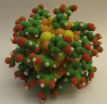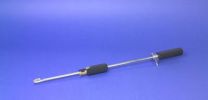(Press-News.org) Nanometre-scale gold particles are currently intensively investigated for possible applications in catalysis, sensing, photonics, biolabelling, drug carriers and molecular electronics. The particles are prepared in a solution from gold salts and their reactive gold cores can be stabilised with various organic ligands. Particularly stable particles can be synthesised by using organothiolate ligands that have a strong chemical interaction to gold. The chemical process of preparing such particles has been known since the mid-1990s and many different stable sizes and compositions are known.
However, the first definite information of their atomic structure became available only in 2007 when the group of Roger Kornberg (Chemistry Nobel Laureate 2006) at Stanford University succeeded in making single crystals for X-ray diffractometry containing only one type of a particle having 102 gold atoms and 44 thiolate ligands, the so called Au102(p-MBA)44 particle. The structure was reported in Science in late 2007 [1]. The theoretical analysis of this and other thiolate-protected gold clusters, led by Professor Hannu Häkkinen at the University of Jyväskylä in Finland, resulted in a theoretical framework that can be used to understand the stability and electronic structure of these particles. This work was reported in the Proceedings of the National Academy of Sciences in 2008 [2].
Now, researchers in the Department of Chemistry and the Nanoscience Center (NSC) at the University of Jyväskylä, in collaboration with the Kornberg group, report the first full spectroscopic characterisation of the absorption of electromagnetic radiation by the Au102(p-MBA)44 particle in solution and solid phases. The study was published in the Journal of the American Chemical Society on 24 February 2011 [3]. The spectroscopic study was performed in a large range of electromagnetic spectrum from mid-infrared ("heat absorption") to ultraviolet light.
"The study was technically demanding and could only be made now when the Stanford group has succeeded in refining the synthesis to produce pure Au102(p-MBA)44 product in large quantities," explains Adjunct Professor Mika Pettersson, who led the experimental work at the NSC. "We document clear "fingerprint" features in the absorbance spectrum that can be used in the future to benchmark chemical modifications of this particle for various applications. The work also establishes the molecular nature of the clusters by the observation of a band gap of 0.45 eV, in excellent agreement with theory. We were able to analyse these features from large-scale computations using the known structure of Au102(p-MBA)44 and thus fully understand the absorption characteristics of this particle," says Professor Häkkinen.
INFORMATION:
The other researchers involved in the work are Eero Hulkko, Jaakko Koivisto and Olga Lopez-Acevedo from the University of Jyväskylä. The pure samples of the Au102(p-MBA)44 particle were made by Yael Levi-Kalisman in the Kornberg group. The work at the NSC and the Department of Chemistry at the University of Jyväskylä is funded by the Academy of Finland. The massively parallel computations, using up to 2048 processor cores, were made in the Louhi supercomputer at CSC – the IT Center for Science.
1. P.D. Jadzinsky, G. Calero, C.J. Ackerson, D.A. Bushnell and R.D. Kornberg, "Structure of a thiol monolayer-protected gold nanoparticle at 1.1. Ångstrom resolution", Science 318, 430 (2007) (www.sciencemag.org/content/318/5849/430.abstract).
2. M. Walter, J. Akola, O. Lopez-Acevedo, P. D. Jadzinsky, G. Calero, C. J. Ackerson, R. L. Whetten, H. Grönbeck, H. Häkkinen, "A unified view of ligand-protected gold clusters as superatom complexes", Proc. Natl. Acad. Sci. (USA) 105, 9157 (2008) (www.pnas.org/content/105/27/9157). See also http://gtresearchnews.gatech.edu/newsrelease/gold-nanoclusters.htm.
3. E. Hulkko, O. Lopez-Acevedo, J. Koivisto, Y. Levi-Kalisman, R.D. Kornberg, M. Pettersson and H. Häkkinen, "Electronic and vibrational signatures of the Au102(p-MBA)44 cluster", J. Am. Chem. Soc., online Communication February 24, 2011 : (http://pubs.acs.org/doi/abs/10.1021/ja111077e)
More information: Professor Hannu Häkkinen, University of Jyväskylä, tel. +358 400 247 973, hannu.j.hakkinen@jyu.fi
Fingerprints of a gold cluster revealed
Nanometer-scale gold particles are currently intensively investigated for possible applications in catalysis, sensing, photonics, biolabeling, drug carriers and molecular electronics
2011-03-01
ELSE PRESS RELEASES FROM THIS DATE:
Exploring religion, youth and sexuality
2011-03-01
Sexuality and religion are generally considered uncomfortable bedfellows. Now, for the first time, a team of researchers from Nottingham have carried out a detailed study around these issues and how they affect and influence the lives of British 18 to 25 year olds.
Led by The University of Nottingham, in collaboration with Nottingham Trent University, experts spent two years investigating the attitudes, values and experiences of sex and religion among young adults.
The study, which involved nearly 700 young people from six different religious traditions; Buddhism, Christianity, ...
An Alzheimer's vaccine in a nasal spray
2011-03-01
One in eight Americans will fall prey to Alzheimer's disease at some point in their life, current statistics say. Because Alzheimer's is associated with vascular damage in the brain, many of them will succumb through a painful and potentially fatal stroke.
But researchers led by Dr. Dan Frenkel of Tel Aviv University's Department of Neurobiology at the George S. Wise Faculty of Life Sciences are working on a nasally-delivered 2-in-1 vaccine that promises to protect against both Alzheimer's and stroke. The new vaccine repairs vascular damage in the brain by rounding up ...
Drug to fight tumors also fights the flu and possibly other viruses
2011-03-01
Ever get a flu shot and still get the flu? If so, there's new hope for flu-free winters in the years to come thanks to a new discovery by researchers who found that a drug called DMXAA, originally developed as anti-tumor agent, enhances the ability of flu vaccines to ward off this deadly virus. A new research report appearing in the March 2011 issue of the Journal of Leukocyte Biology (http://www.jleukbio.org) suggests that DMXAA could assist flu vaccines by causing the body to produce its own antiviral proteins, called interferons, which interfere with the virus's ability ...
Surgical instruments with electronic serial numbers
2011-03-01
Be it a heart transplant or a Cesarean section, every operation requires a wide variety of surgical instruments, from simple retractors, clamps, scalpels and scissors to more specialist devices such as cerclage wire passers, which surgeons employ to repair long, oblique fractures in bones. These are shaped in such a way as to half encircle the broken bone, and incorporate a hollow channel. In a process not unlike stringing a parcel for posting, thread or wire is fed through the channel around the damaged bone and then knotted in place, both to support the bone and to hold ...
Minimally invasive surgeries: Laser suturing
2011-03-01
More and more often, abdominal surgeries are being carried out in a minimally invasive manner. A small incision in the abdominal wall is sufficient for the surgeon to be able to insert the instrument and make the organs visible with an endoscope. This technique is gentler and does not stress the body as much as traditional surgeries do. However, these minimally invasive surgeries pose a special challenge to the surgeons. In particular, the suturing – meaning joining the tissue with needle and suture material - demands great skill and dexterity. Very often, piercing the ...
U. Iowa team investigates function of 'junk DNA' in human genes
2011-03-01
Part of the answer to how and why primates differ from other mammals, and humans differ from other primates, may lie in the repetitive stretches of the genome that were once considered "junk."
A new study by researchers at the University of Iowa Carver College of Medicine finds that when a particular type of repetitive DNA segment, known as an Alu element, is inserted into existing genes, they can alter the rate at which proteins are produced -- a mechanism that could contribute to the evolution of different biological characteristics in different species. The study was ...
Compound useful for studying birth defects may also have anti-tumor properties
2011-03-01
In an interesting bit of scientific serendipity, researchers at North Carolina State University have found that a chemical compound useful for studying the origins of intestinal birth defects may also inhibit the growth and spread of cancerous tumors.
During the screening of chemical compounds created by NC State chemist Dr. Alex Deiters, developmental biologist Dr. Nanette Nascone-Yoder found one of particular interest to her research: a compound that induced heterotaxia, a disordering or mirror-image "flipping" of internal organs, in the frog embryos she was studying. ...
Blood pressure management: Sleep on it
2011-03-01
A daytime sleep could have cardiovascular benefits according to new research by Ryan Brindle and Sarah Conklin, PhD, from Allegheny College in Pennsylvania in the US. Their study, looking at the effect of a daytime nap on cardiovascular recovery following a stress test, found that those participants who slept for at least 45 minutes during the day had lower average blood pressure after psychological stress than those who did not sleep. The work is published in Springer's journal International Journal of Behavioral Medicine.
Long work schedules, shift work, increased anxiety ...
IDIBELL researchers discover a substance against the 'dark genome' of cancer
2011-03-01
A research study coordinated by Manel Esteller, researcher at Bellvitge Biomedical Research Institute (IDIBELL) has identified a substance that inhibits cancer growth by activating the so‑called "dark genome" (or non‑coding DNA) and micro‑RNA molecules. The study appears this week in the journal Proceedings of the National Academy of Sciences (PNAS).
Human body cells have a genome (the set of our DNA) encoding our proteins such as keratin in the skin or haemoglobin in blood. This genome with encoding DNA represents only the 5% of our genetic material. ...
University of Cincinnati research presented at international criminal justice meeting
2011-03-01
About 1,200 criminal justice researchers as well as active and retired law-enforcement professionals from around the world are expected to attend the annual meeting of the international Academy of Criminal Justice Sciences, to be held March 1-5 in Toronto. Presentations of the latest research in the field will be made, including research presented by the University of Cincinnati faculty and students.
Recognized at the conference will be UC researchers Bonnie Fisher, professor, and Francis Cullen, distinguished professor. Fisher and Cullen will receive the 2010 Outstanding ...
LAST 30 PRESS RELEASES:
Heart-brain connection: international study reveals the role of the vagus nerve in keeping the heart young
Researchers identify Rb1 as a predictive biomarker for a new therapeutic strategy in some breast cancers
Survey reveals ethical gaps slowing AI adoption in pediatric surgery
Stimulant ADHD medications work differently than thought
AI overestimates how smart people are, according to HSE economists
HSE researchers create genome-wide map of quadruplexes
Scientists boost cell "powerhouses" to burn more calories
Automatic label checking: The missing step in making reliable medical AI
Low daily alcohol intake linked to 50% heightened mouth cancer risk in India
American Meteorological Society announces Rick Spinrad as 2026 President-Elect
Biomass-based carbon capture spotlighted in newly released global climate webinar recording
Illuminating invisible nano pollutants: advanced bioimaging tracks the full journey of emerging nanoscale contaminants in living systems
How does age affect recovery from spinal cord injury?
Novel AI tool offers prognosis for patients with head and neck cancer
Fathers’ microplastic exposure tied to their children’s metabolic problems
Research validates laboratory model for studying high-grade serous ovarian cancer
SIR 2026 delivers transformative breakthroughs in minimally invasive medicine to improve patient care
Stem Cell Reports most downloaded papers of 2025 highlight the breadth and impact of stem cell research
Oxford-led study estimates NHS spends around 3% of its primary and secondary care budget on the health impacts of heat and cold in England
A researcher’s long quest leads to a smart composite breakthrough
Urban wild bees act as “microbial sensors” of city health.
New study finds where you live affects recovery after a hip fracture
Forecasting the impact of fully automated vehicle adoption on US road traffic injuries
Alcohol-related hospitalizations from 2016 to 2022
Semaglutide and hospitalizations in patients with obesity and established cardiovascular disease
Researchers ‘listen in’ to embryo-mother interactions during implantation using a culture system replicating the womb lining
How changing your diet could help save the world
How to make AI truly scalable and reliable for real-time traffic assignment?
Beyond fragmented markets: A new framework for efficient and stable ride-pooling
Can shape priors make road perception more reliable for autonomous driving?
[Press-News.org] Fingerprints of a gold cluster revealedNanometer-scale gold particles are currently intensively investigated for possible applications in catalysis, sensing, photonics, biolabeling, drug carriers and molecular electronics



